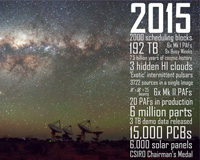2015: An ASKAP year to remember
21 December 2015
As the end of the year approaches, now is a time to reflect on the major achievements of the Australian SKA Pathfinder (ASKAP) project in 2015, thanks to the team staff based in CSIRO Astronomy and Space Science offices across Australia (Sydney, Perth, and Geraldton), those on the ground at the Murchison Radio-astronomy Observatory (MRO), and also international collaborators.
The year started with an impressive 150 square degree image of the Tucana constellation produced by the commissioning team. Using six Mk I phased array feed (PAF) receivers installed at the MRO – the Boolardy Engineering Test Array, or BETA – to demonstrate the rapid, wide-area survey capability of the ASKAP telescope, this image was over three times the size of previous efforts.
Regular ‘Busy Weeks’ for the ASKAP Early Science and Commissioning (ACES) team resulted in significant progress and a number of technical memoranda focused on understanding the intricate workings of BETA, including beamforming, polarimetry, PAF performance, antenna pointing, using ASKAPsoft, RFI mitigation and preparation for data processing with the next generation (Mk II) PAFs on the telescope. Over the course of the year, the team collected approximately 192 TB of commissioning data across 2000 scheduling blocks.
The first initial science papers based on BETA commissioning data were published this year, capitalising on the unique capabilities of the telescope and radio quiet environment of the MRO. From mapping a galaxy group to reveal three previously unknown neutral hydrogen (HI) clouds, to the discovery of HI absorption in a galaxy 5 billion light years away, to confirming theoretical predictions about an ‘exotic’ intermittent pulsar, the results provided a teaser of what the full ASKAP may be capable of in the future.
Making significant headway towards ASKAP Early Science in 2016 is also the team behind the ASKAP Computing systems, working closely with ACES and the ASKAP Survey Science Teams to deliver the bespoke software, ASKAPsoft. The recent initial release of 3TB of demonstration data will provide valuable insight for the team developing the CSIRO ASKAP Science Data Archive (CASDA) and reinforces the importance of open access to data.
2015 may have been the year of BETA, but in the coming year the ASKAP Early Science program will take advantage of the significant improvement in performance offered by CSIRO’s next generation of ASKAP receivers – the Mk II PAF.
Six Mk II PAFs have now been successfully installed on antennas at the MRO, with commissioning activities already bearing impressive results, including the first ever 16 beam image to be produced with the PAF receivers – a record that was quickly broken as the latest number coming from the site is now a 25 beam image with five Mk II systems.
Back in Marsfield, Sydney, there are around 20 more Mk II PAFs on the production line in the workshop, and a number of completed systems undergoing final system tests or already crated and ready for deployment to site.
A number of key milestones were also reached this year for the team working on power supply to the MRO, with the appointment of Perth-based EMC for some 6000 solar panels and Australia’s largest battery storage system to help power the MRO, as well as an announcement from the WA State Government approving a funding agreement between Horizon Power and CSIRO. These steps will lead toward the construction of a permanent hybrid power station for the site.
The international Square Kilometre Array (SKA) project experienced a number of key events through the year that has carried the telescope a step closer to the construction phase, including the release of the SKA Science Book, the SKA Science and SKA Engineering Meetings that brought together international scientists and engineers involved in planning and design of the mega-science project, as well the announcement of a permanent headquarters in the UK.
CSIRO continued its involvement in the SKA project through seven of the 11 SKA R&D consortia (and leading two of these: Dish and Infrastructure-Australia), as well planning with Australian astronomers on the Key Science Projects and working together with Australian industry together towards SKA1.
Valuable progress in SKA planning was also made from a national perspective as well, as treaty negotiations with SKA member governments – including Australia – began, and a recent announcement from the Prime Minister included provisional funding allocation for the SKA as part of the National Innovation and Science Agenda.
ASKAP's achievements of 2015 cannot be denied, but recognition in the award of CSIRO’s highest honour – the Chairman’s Medal – certainly validated the hard work of the whole team that has brought the project to where it is today.
Heading into 2016, the team looks forward to the start of ASKAP Early Science, the installation and commissioning of Mk II PAFs at the MRO, and the further expansion of the Perth office – especially with an increased expertise in low frequency radio astronomy.
To receive regular updates on ASKAP developments, sign up to the ASKAP Update and the ASKAP Commissioning Update.
Back to Latest ASKAP News page.

